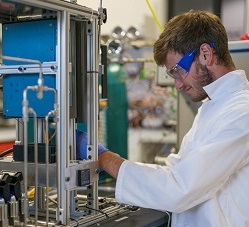As with most research, building an understanding of ideas and theories begins long before you enter the lab. This was true of my research in the catalysis lab last summer. I spent hours reading and analyzing research articles pertaining to similar projects and outcomes, looking for opportunities to apply a different perspective, my perspective, to improve or re-design what has previously been done. I entered Kingsbury Hall each day with a loosely configured plan, or recipe, much like a chef who makes wonderful creations from ingredients that have been painstakingly measured and synthesized multiple times until perfection. I wanted to help make the methane conversion process better, more efficient in cost and production, and for the outcome to have a greater impact. So, what is it that I did each week?

My REAP project’s aim was to combat the effects of climate change on the Earth by working to improve the Sabatier reaction, which converts hydrogen and carbon dioxide to methane and water. The conversion of carbon dioxide is essential to resolving the climate crisis. The gas has accumulated in the atmosphere, trapping heat and contributing to the greenhouse effect. Therefore, removal of carbon dioxide from the atmosphere through the Sabatier reaction can reverse many damaging global warming effects and provide a promising future for ecosystems worldwide.
For this reaction to become more efficient and increase the possibility of it being used on an industrial scale, a catalyst must be used. A catalyst improves the rate and yield of a process. During my research, I experimented with nickel-based catalysts modified with titanium dioxide and heteropoly acids to improve the reaction’s efficiency. These became my daily ingredients of which I must find the optimal combination to produce the best outcome.
In development, the process of making a catalyst is like that of creating a recipe for a cake. There are many variables that need to be tested, one at a time, to find the perfect method of synthesis. The ingredients are combined, separated, and purified during the process. I used a single pot method to combine the ingredients, which were dissolved and stirred together for a day to increase their molecular interaction with one another. Once combined, the water then had to be separated from the rest of the catalyst. This is because water has a detrimental effect on the Sabatier reaction. I used a rotary evaporator to suction out most of the liquid, doing this through pressure and temperature. Then, the dry sediment was placed in a vacuum oven for a day. Once dry, the catalyst was then calcined, or heated to a high temperature to make the ions and charges of the nickel more favorable. This four-hour calcination step took place in a kiln.
Once the catalyst was finished, I tested it for stability, selectivity, and activity by performing an activity test. This six-hour process involves pretreating the catalyst and carrying out the Sabatier reaction. To pretreat a sample, the catalyst is placed in a controlled environment, a reactor, then flooded with helium. The helium cleans the catalyst’s surface, much like a chef cleans his knife before every cake he cuts. Once the catalyst has been cleaned, the reaction is carried out. The results of this activity test were measured by a gas chromatograph, allowing me to alter the one-pot synthesis method to determine which ratios, temperatures, and materials were most effective.
Throughout my research period, I documented every change in my approach and reported these changes to a group of five other researchers working in the same lab. All of us came together once a week to discuss ideas for improvement and to review our data. If something did not work out as expected, we would go back to the drawing board. New ideas for possible combinations or variables to change would often come up. If a problem arose, a more experienced lab member might have already run into the same issue and could advise me on a solution, or everyone would help trouble shoot. The collaborative effort among the lab created a positive community in which failing was accepted and success was praised.
Research is an ever-evolving process of creating and analyzing the results. Like the chef who is perpetually challenged by new ideas, ingredient combination, and proportions for the perfect cake, I am in search of the best catalyst for the purpose of carbon dioxide methanation.
